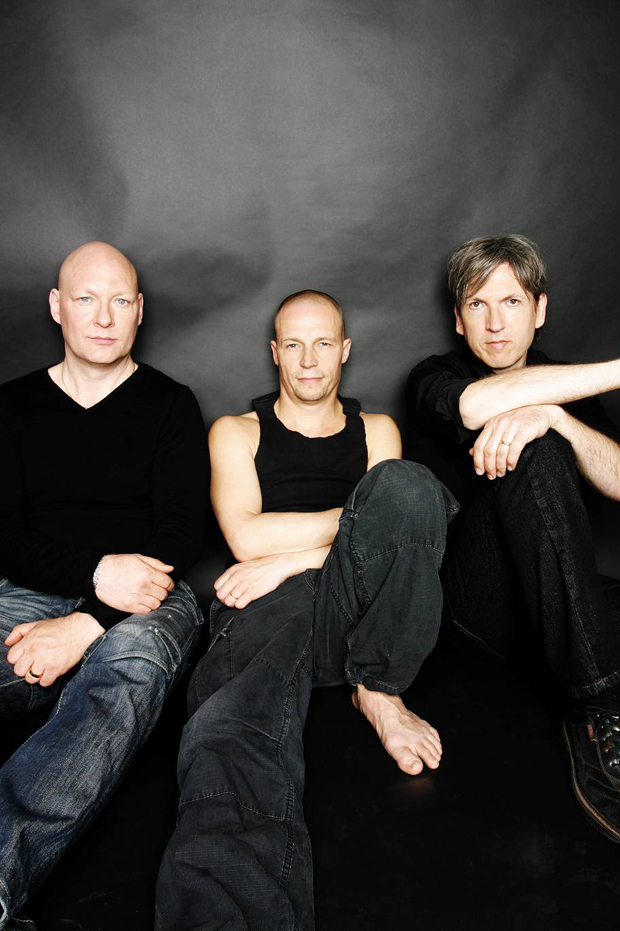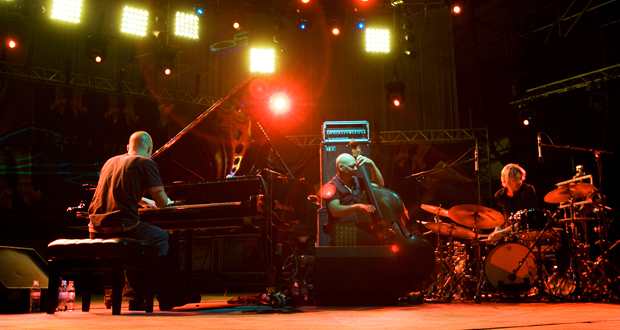EST – Three Falling Three
Thursday, July 23, 2015
Just months before Esbjörn Svensson died aged just 44 in 2008, EST – the groundbreaking and hugely influential piano trio that Svensson formed with Dan Berglund and Magnus Öström – recorded a great deal of material in a Sydney studio.

Jazz albums like EST’s 301 don’t come around every day. Or every month, or even every year. In fact, rather like the Beast of Bodmin Moor, ocelots or the Abominable Snowman, albums as gob-smackingly good as this are a decided rarity. Suddenly, out of the blue (and appropriately the album cover art is strikingly blue), comes this session by pianist Esbjörn Svensson, bassist Dan Berglund and drummer Magnus Öström from January 2007. Recorded in Sydney’s Studio 301 in their down-time during a tour of Australia, they amassed a total of nine hours of material, some of which was previously released as the album Leucocyte in 2008. Yet 301 sounds as if it was recorded on a different planet in a different universe – it roars where Leucocyte simmers, it powers where Leucocyte is polite and it packs a powerful emotional punch where Leucocyte gives you a peck on the cheek.
Since Esbjörn Svensson’s tragic death in June 2008, the tapes of these sessions had been in storage, the thought of revisiting the material too painful. The idea had been to release a double CD, or two consecutive albums, from their marathon Australian date, but Svensson’s untimely passing put an end to these plans and in the event, only Leucocyte was released. It was not until the summer of 2011 that Dan Berglund and Magnus Öström felt able to revisit the material, and they were delighted at what they discovered. “It had been sitting there all that time,” says Öström. “Esbjorn did most of the editing on Leucocyte, so where we listened to all that material before, I was not that careful, maybe. So when we came to listen to it again I was really surprised that it was on such a level. It sounded so fresh, so I was really happy about it, that we had some good quality material for release.” Berglund agrees, adding, “We were supposed to have released a double CD, but in the end we released a single but although we knew we had some more material I was surprised that there was so much that I really liked.”
Together with EST’s former sound engineer Åke Linton, who sat behind the mixing desk at over 500 EST concerts, they edited down some of the very best material for release. The idea behind the sessions was to go into the recording studio without any preparation and just play. “The idea was something like we tried in 2000, or 2002,” recalls Öström. “Just go in the studio and kind of redeem ourselves! Get whatever we had of ourselves out of our system and on to tape, like a catharsis thing. We just play for fun and see what comes out. With this recording we wanted to test the energy level we had during a tour, and also try and test the improvised parts that had grown bigger and bigger through the years we played live, and put that on tape. We had in mind maybe making a record, of course we didn’t know how it would turn out, but that was the thinking behind it. The approach was that we set up the gear, get a good sound – a good balance – and then push the ‘record’ button. It was all from scratch, we didn’t have any pre-planning, pre-thinking; one of us started and the other two followed and we went from there. Totally free, actually. We’d play one hour, one hour and a half, have a break – we just went for it!”
 On tracks such as ‘Three Falling Free Part II’, ‘Inner City, Inner Lights’ and ‘The Childhood Dream’ you realise what an extraordinary pianist Esbjörn Svensson was. Not only in terms of his emotional range, but also that fact that in live performance and on record, he kept his extraordinary virtuoso technique under wraps. However, here we get a glimpse of Esbjörn unbridled. It brought to mind an EST recording session at the Atlantis recording studio in Stockholm I attended. Arriving early, Svensson was already at the piano warming up before the rest of the band arrived. His back was to the control room, facing Berglund’s bass, on its side on the studio floor, and Öström’s drum kit. He had no idea anyone else was in the studio other than recording engineer Janne Hansson, who was attending to the sound level while sipping a cup of strong, early morning black coffee. Svensson, midway through a Chopin étude, followed it with impeccably played sections from the first movement of Beethoven’s Fifth Piano Concerto in C, his touch, technique and attention to dynamics of a concert pianist’s standard, and then he abruptly segued into a high tempo 12-bar blues that went on and on, never repeating himself, building and building to a wonderful, block chorded climax. Hansson, who had recorded several Abba hits in these very studios, looked across and smiled the smile of someone who had seen it all, but had witnessed something special. Svensson was stunning. Relaxing after the session in a sushi bar, I asked him why he never allowed this virtuosity to show through on either records or in live performance. “Because it’s not me,” he said simply.
On tracks such as ‘Three Falling Free Part II’, ‘Inner City, Inner Lights’ and ‘The Childhood Dream’ you realise what an extraordinary pianist Esbjörn Svensson was. Not only in terms of his emotional range, but also that fact that in live performance and on record, he kept his extraordinary virtuoso technique under wraps. However, here we get a glimpse of Esbjörn unbridled. It brought to mind an EST recording session at the Atlantis recording studio in Stockholm I attended. Arriving early, Svensson was already at the piano warming up before the rest of the band arrived. His back was to the control room, facing Berglund’s bass, on its side on the studio floor, and Öström’s drum kit. He had no idea anyone else was in the studio other than recording engineer Janne Hansson, who was attending to the sound level while sipping a cup of strong, early morning black coffee. Svensson, midway through a Chopin étude, followed it with impeccably played sections from the first movement of Beethoven’s Fifth Piano Concerto in C, his touch, technique and attention to dynamics of a concert pianist’s standard, and then he abruptly segued into a high tempo 12-bar blues that went on and on, never repeating himself, building and building to a wonderful, block chorded climax. Hansson, who had recorded several Abba hits in these very studios, looked across and smiled the smile of someone who had seen it all, but had witnessed something special. Svensson was stunning. Relaxing after the session in a sushi bar, I asked him why he never allowed this virtuosity to show through on either records or in live performance. “Because it’s not me,” he said simply.
When I related this story to Dan Berglund and Magnus Öström, Berglund was first to respond: “He never was really interested in showing-off in records or in concerts,” he said. “That was not his way – we were interested in making good music together. I think when I listen to very good musicians you can feel if they can play very, very fast but they don’t. That’s even more interesting.”
"We were safe in that room and he went for it without any worries, he felt free"
However, both agree that the circumstances of the recording session, where the doors were closed and where any of them were free to take their playing in any direction they wanted had contributed to Svensson revealing a little of the inner-man that had remained under wraps to the public at large. “It could be it was the moment for trying out stuff, feeling free, in a way no-one listens,” reflects Öström. “You don’t have to have any borders in any sense, if he wanted to play more difficult stuff he felt safe, so to speak. No-one but us listening. We were safe in that room and he went for it without any worries, he felt free in his mind to do what he wanted and try what he wanted, he felt free, extraordinarily free and more confident, maybe, I don’t know, we never discussed it. I don’t know where it should have gone had he lived, I don’t know. It might be that he felt that this is working because he was always playing and always practising all the time and his level was moving ahead all the time, he was moving forward all the time, so maybe this was a new step to integrate it into his playing and integrate it into himself as well. Bring out the classical side more – I don’t know, I am just speculating.”
Certainly great art can be achieved by knowing how to limit yourself, and in jazz there is no better exemplar of the less-is-more ethic than Miles Davis – Kind of Blue, a player who once could have been mistaken for Dizzy Gillespie (check out his playing with the Metronome All Stars from January 3, 1949 on ‘Overtime’), yet chose to limit himself to the notes that really mattered. Equally Svensson, reflecting in part the influence of the great Swedish pianist Jan Johansson, chose to pare his playing down to the very essence of melody, rather than flaunt his remarkable technique. Of course, there are moments when we have glimpses of his technique, but always in service of the song, not himself, and never to the extent that is captured on 301.
The less-is-more analogy (and nobody is suggesting Esbjörn Svensson was another Miles Davis, only to suggest one of many precedents in jazz that include, among others Count Basie and Lester Young) is not the only one that might be made. From 1969 until Davis’ furlough from the music business in 1975, his albums were constructed largely through spontaneous, free flowing jams that were edited after the event by Teo Macero to produce some classic recordings, not least In a Silent Way and Bitches Brew.
Certainly EST were not thinking of Miles Davis when they went into Studio 301 in January 2007, but the modus operandi was coiincidentally similar, even though their aims were quite different (again, this is not to suggest Esbjörn was another Miles, but rather to highlight the circumstances of the album’s creation does have several precedents, from Davis to free jazz and many points in-between).
What is interesting, and perhaps the least commented aspect of the album 301 is the use of electronics, which is far greater than anything EST had done live or on record. Here, EST’s sound engineer Åke Linton participated in the creative process. During the recording he contributed to the music by running effects, overlaying distortions and add-ins live through the desk during the recording process onto tape. It’s a procedure that cannot be reversed in the re-mixing process. His electronic prestidigitation was in addition to that of Svensson’s electronics (who at one point also uses a transistor radio for effects) and the electronic sounds generated by the laptops of Magnus Öström and Dan Berglund.
“We wanted to experiment in the studio and we had the chance to do it,” says Berglund. “We did electronic improvisation on stage – between songs, and at the beginning and at the end of songs – so now we had a chance to really try that out, expand on that a little, and I think sometimes we were recording one song an hour, I like this approach – acoustic and electronics. Would it have meant we would have done more and more? – I don’t know really.” And in his role as drummer and arch percussionist within the EST ensemble, Magnus Öström was perhaps the main instigator of electronics in live performance, often colouring ensembles and interludes behind Svensson and Berglund. “When I think about myself as a drummer, I’m not really a ‘drummer, drummer’,” he says.
“I like sounds and different colours and that’s how I also approach electronics, it’s more like a new colour – it could be a new cymbal, a new drum sound – whatever, but sometimes it happens to be electronics and that’s how I approach it. I wanted to integrate it into the acoustic sound, then it hopefully becomes organic with ordinary drum sounds, that for me is very important, that it is not seen as ‘now it’s acoustic’ and ‘now it’s electronics’ and you go back and forth, but like it’s more new colours and some just happen to be electronics.”
Listening to 301, an inevitable question arises. Is there any more material suitable for release by EST in the vaults and if so, can fans look forward to further albums like this? Dan Berglund pauses, and says: “I think if we go through the material and we think there is more, then maybe, but for the moment that’s enough. Of course it would have to be very good quality to release it, if there was anything not that good we would not release it.” Magnus Öström nods in agreement.

So if there are no plans for any more releases for the moment, are there plans for the bassist and drummer to collaborate in the future? Here, Öström replies, “At the moment, we have said this before, for a while we need to find our own path with our own projects. You never know, we did this celebration for Esbjorn together at a festival in Germany last summer, we played with Pat Metheny and other guys and it was really fun, so you never know what in the future might happen. Of course, it is easy to pick things up when we get together, but first we’ll have to find the right environment and find something that we really think it is worth it and that will be hard to do.” Berglund nods, adding: “I agree, for the moment I’m working with Tonbruket and Magnus is working with his band, I think we need to stand on our own for a while and then see if we really want to do something else together – but you never know.” So Dan and Magnus are not ruling anything out, but equally they are not ruling anything in. But you only have to hear the remarkable empathy they shared on 301, which by the nature of its spontaneous construction is perhaps more revealing of their sympathetic, spontaneous reaction to one another’s improvisational impulses than their playing within a preconceived original composition, to realise they have something special together. So would they rule out collaborating with another pianist? “I don’t know,” says Öström thoughtfully.
“It would be hard to think of doing that. As time goes by it may happen – you never know. For me, at the moment I am in a group with Lars Danielsson and Tigran, and we recorded an album out on ACT called Liberetto – of course it’s not a piano trio, it also has Arve Henriksen and John Parricelli – but I love the sound of the piano and I love the feeling, it might happen in the future. It will be something else, but I love the piano, the sound of the piano and love to play piano myself, so we’ll see. It’s not a closed door, but for the moment I am set up with Lars and I’m happy with that. We’ll see where it goes.” Berglund nods in agreement, adding: “I also think that would be hard, to start another trio. But as Magnus says, you never know. We’re doing this little thing with Jamie Cullum for his radio show, we’re going to play one or two songs together, but we have no plans to start a new EST!”
This article originally appeared in the April 2012 issue of Jazzwise. EST's 301 is also included in Jazzwise's Top 20 Jazz albums of the last five years.
Photos: first image by Christian Coinbergh, second image byJoerg Grosse-Geldermann; third image by Tim Dickeson
Robert Glasper and John Surman help Manchester Jazz Fest hit 20 in style – plus exclusive Stuart McCallum track
Robert Glasper and John Surman help Manchester Jazz Fest hit 20 in style – plus exclusive Stuart McCallum track
Robert Glasper and John Surman help Manchester Jazz Fest hit 20 in style – plus exclusive Stuart McCallum track
Robert Glasper and John Surman help Manchester Jazz Fest hit 20 in style – plus exclusive Stuart McCallum track